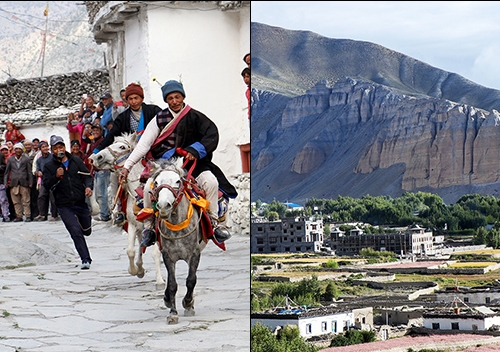Upper Manang, Upper Mustang, and Upper Dolpo the high-altitude deserts are some of the most fascinating areas in the Himalayas of Nepal. Known locally as "Himal Pari Ko Jilla," or "the district behind the Himalayas", these regions lie beyond the Annapurna and Dhaulagiri mountain ranges. Located in the rain shadow area in Nepal, they are often called the cold deserts in Nepal. While the Himalayas have snowy peaks and green valleys, these massive mountains block rain, creating the dry, desert-like landscape that defines Upper Manang, Mustang, and Dolpo.
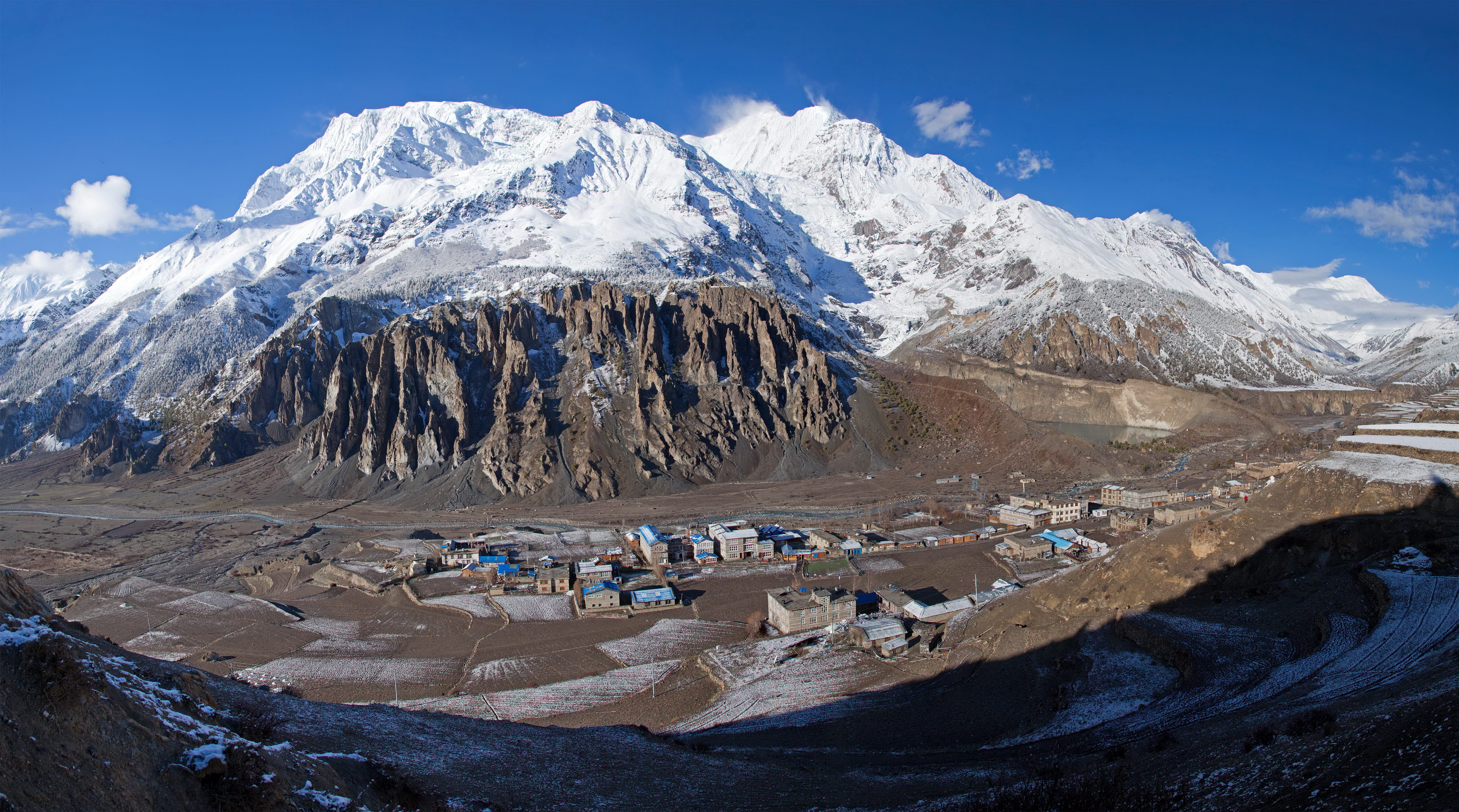
Manang and Mustang are two districts on either side of the Annapurna and Dhaulagiri mountain ranges in northern and northwestern Nepal. These areas receive only about 200-300 mm of rainfall each year. As moist air travels northward over the southern slopes of the Himalayas, it cools and causes rain. By the time the air reaches the northern side, it has lost most of its moisture, creating a "rain shadow." This makes Manang and Mustang dry, with arid landscapes, wide-open views, and sparse vegetation. Their terrain resembles the Tibetan Plateau, often sitting at elevations above 3,500 meters (11,500 feet).
Manang, above everything else, attracts trekkers through its magnificent routes, including the Annapurna Circuit trek. Along this trail, one will admire changes in the face of vegetation as altitude rises. Within less than one week, one is shifted from thick forests both barren and rocky terrain. Mustang also known as the ‘forbidden kingdom’ has a similar landscape to Manang. The upper region of these places is arid, with fascinating rock formations leaving one to wonder why the Manang and Mustang regions are so dry.
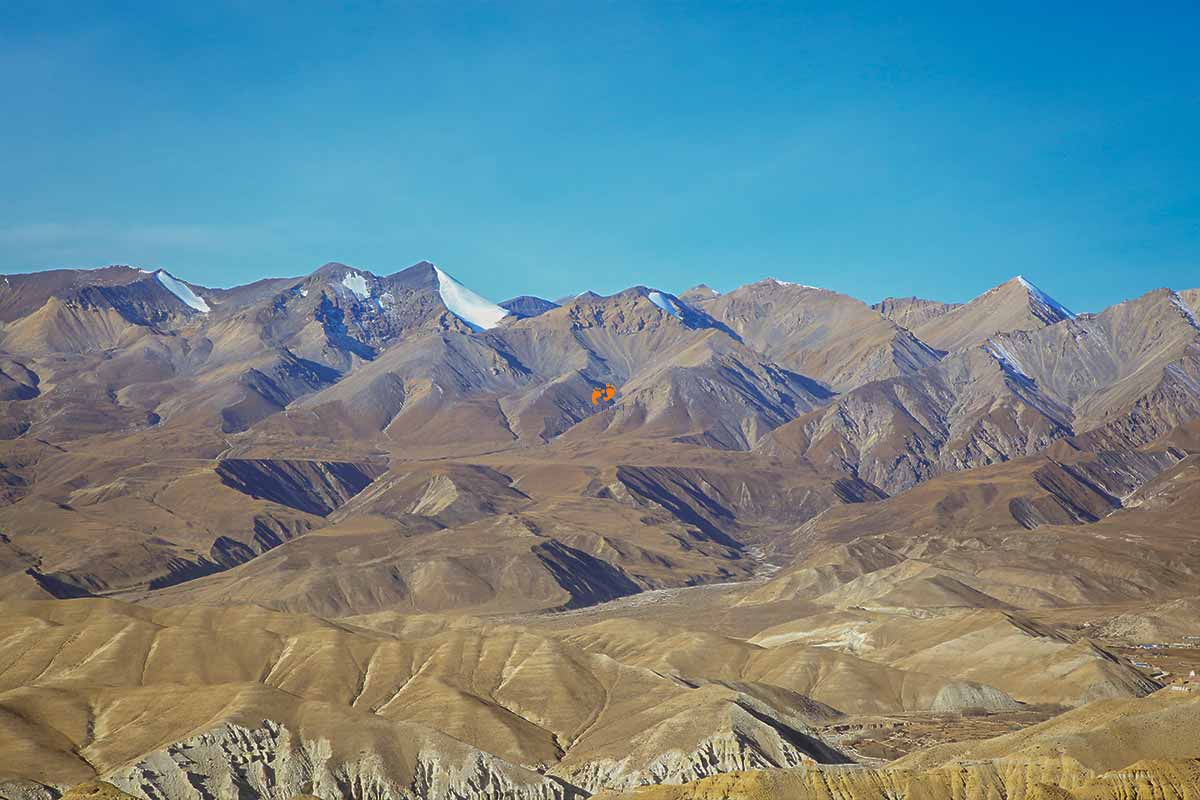
High-altitude desert geology is quite remarkable. Wind and water erosion have formed unusual rock formations that include deeply cut valleys such as the Kali Gandaki Gorge, one of the deepest gorges in the world. These geological features together with the special climate make Manang and Mustang very attractive places for biodiversity, climate change, and adaptation by people to extreme environments.
People from Manang and Mustang have learned to thrive even in the harsh conditions of these high-altitude deserts. They have built traditional houses, devised methods of farming, and retained cultural traditions that speak of their strength and ingenuity. These high-altitude deserts are not pieces of barren land; they are vibrant areas where different life and nature abound.
Why Manang and Mustang are Desert?
Due to a combination of geographical and climatic factors, Manang and Mustang are considered deserts despite being surrounded by some of the highest mountains in the world. These regions lie north of the Annapurna and Dhaulagiri mountain ranges, which act as a barrier that prevents moist air from reaching them. As a result, Manang and Mustang experience significantly less rainfall compared to the southern slopes of the Himalayas.
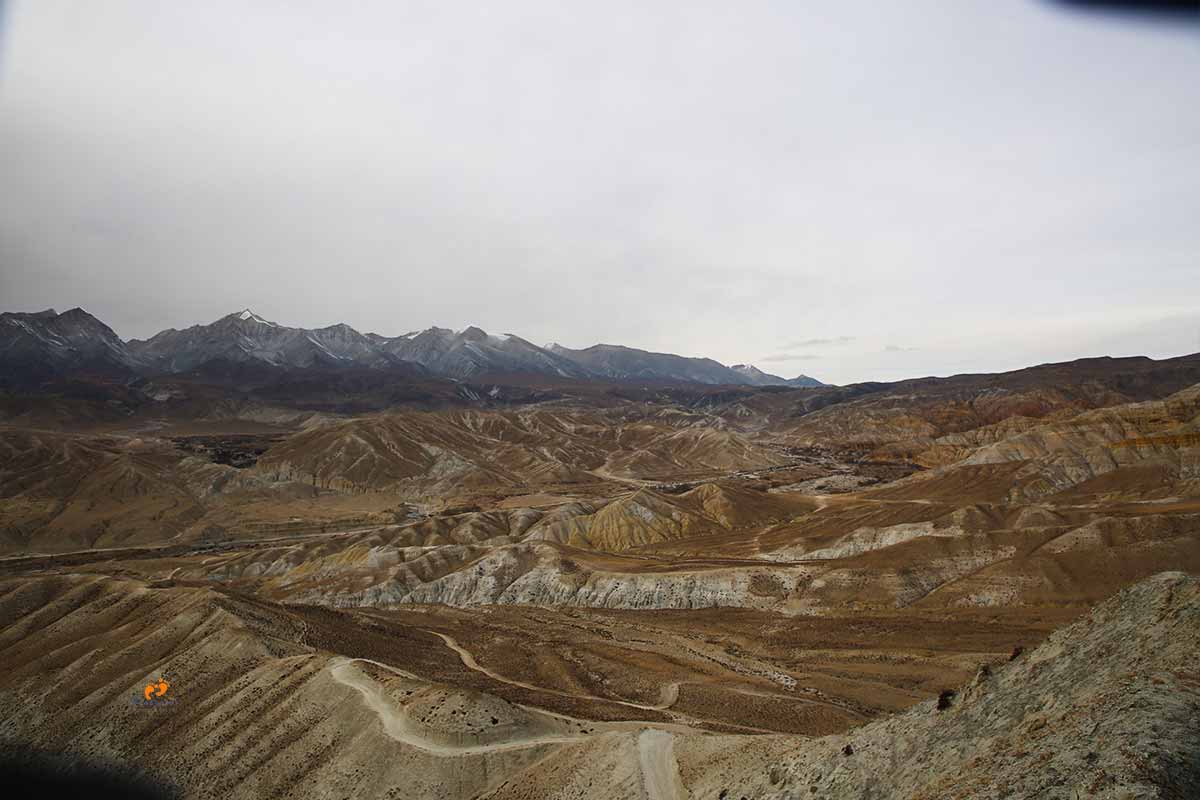
The process known as the rain shadow effect illustrates why Manang and Mustang are deserted. Moist air from the Bay of Bengal moves northward, hitting the Himalayas. When this air rises to pass over the mountains, it cools and releases rain on the southern slopes. By the time the air descends into Manang and Mustang, it has lost most of its moisture, leading to the dry conditions characteristic of these regions.
The climate in Manang and Mustang further supports their desert classification, having cold winters with temperatures often dropping below freezing and relatively mild summers. These areas receive very little precipitation annually, often less than 300 millimeters, which adds to their desert-like environment. The soil in Manang and Mustang is typically grainy, rocky, and sandy, with sparse vegetation. Only hardy plants that can survive dry conditions, such as junipers and thorny bushes, can grow here, contributing to the desert in the Himalayas.
Strong winds are also common in these high-altitude deserts, leading to soil erosion and shaping unique geological features. These winds sweep across the barren ground, carving deep gorges and rugged cliffs, further enhancing the arid appearance of Manang and Mustang. Collectively, these factors explain why Manang and Mustang are classified as deserts, showcasing a fascinating contrast to the towering peaks that surround them.
Landscape of the High Altitude desert of Nepal
The high-altitude deserts of Manang and Mustang in Nepal see some of the most unique landscapes on Earth, sculpted through thousands of years. Protected by the towering Himalayas from the rains, these regions represent dry terrain stretching as far as the eye can see.

Here, you will see deep, twisting canyons with layers of rock in earthy colors like yellowish brown, red, and gray each holding a piece of history. Wide flat uplands extend to the horizon, scattered with rugged rock formations that resemble natural sculptures. The wind here is strong and continuously carves cliffs into fortress shapes and tall, narrow towers.
The land itself has been in a constant state of evolution. Steep hillsides get worn over time into rows of natural pillars that reach up to the sky. Ridges and gullies create dramatic light and shadow patterns across the plains, shifting through the day. You will also see major open rock formations that highlight the area's ancient past, loose rock cascading down slopes like rivers of stone.
These colored landscapes-from light beige to deep rusty red-get their colors naturally. Some have mineral deposits underground that give them surprising shades of ochre and terracotta, while salt deposits form bright white patches. Small streams run through a few valleys, allowing hardy plants to grow and giving the brown and gray landscape.
Geographical Location of Manang and Mustang
Manang and Mustang are two regions in Nepal known for their unique geographical features, which contribute to their classification as cold deserts in Nepal. Manang is situated at a latitude of about 28.5784° N and a longitude of 84.0835° E, with elevations ranging from about 1,500 meters or 4,921 feet in the low valleys up to over 7,000 meters or 22,966 feet at peaks such as Annapurna II. It lies north of the Annapurna mountain range, a high-altitude valley system comprising sharp mountain slopes and rugged terrain. To the south, it borders the Marshyangdi River and forms part of the Annapurna Conservation Area.

On the other hand, Mustang is at an elevation of approximately 29.2462° N latitude and 83.9251° E longitude, with elevation ranging from about 2,700 meters to over 6,000 meters above sea level in mountain summits. This area is situated north of the Annapurna and Dhaulagiri ranges and includes the Mustang Valley, which basically consists of high-altitude plateaus. It is characterized by dry riverbeds, high cliffs, and a combination of culture with architecture that includes Tibetan culture.
This aridity, with high altitudes, restricts growth due to a lack of water and proper nutrients. The flora that characterizes the deserts in nature. Soils are rocky, and less fertile, with thin vegetation consisting mainly of hardy shrubs, grasses, and a few floral species; all the plants have adapted to such conditions.
The extreme climatic condition in these deserts limits various diversities of wildlife, though the visibility of some species like snow leopard, Himalayan tahr, and different birds shows their adaptability in such harsh environments. Thus, based on geographical location, altitude, terrain ruggedness, aridity, and climate, Manang and Mustang are outstanding examples of deserts in Nepal. These regions are still exploited in their potential to attract trekkers and adventurous people to explore the magnificent scenery and closely examine the cultural richness.
Climate Characteristics of Manang and Mustang
Due to the high elevation and location backward from the mountain ranges of Annapurna and Dhaulagiri, Manang and Mustang have a cold and dry type of climate making it a desert area in Nepal. Manang lies between 3,500 to 5,000 meters above sea level, and the weather has a cold climate throughout the year. The winter is pretty cold here, along with heavy snowfall, and temperatures are often less than the freezing point. In spring, the snow melts, and the temperature gradually warms up to a comfortable level. The summers in Manang are mostly dry because the mountains obstruct most of the rain from the surrounding monsoon. In autumn, one of the best weathers includes mild days, and cool nights, with clear skies considered as the perfect time for trekking. Most trekkers preferably hike during morning hours because, in many instances, afternoon high-altitude winds usually blow.
/manang.jpg)
Mustang itself is close to the Tibetan plateau, lying at an altitude of 2,800 to 4,000 meters, and hence it is dry and cool. Winters in Mustang are extremely cold, with daytime temperatures around 5°C, and nighttime can go below freezing, especially in Upper Mustang. In spring, the weather is mild, and clear, and is one of the best times for trekking. Mustang is dry even during the monsoon, as the mountains prevent a lot of rain from this area. Autumn again sees clear days and comfortable temperatures; this attracts many people.
Both areas receive very little rainfall. Manang receives approximately 500 mm annually, and Mustang even less roughly 250-300 mm. Most afternoons, strong winds cut through Mustang, so mornings are generally the best time to trek.
Trekking in the High Altitude Deserts of Nepal
These high-elevation deserts of Nepal continue to provide a unique experience for trekkers from the green hills and forests of Nepal. The areas behind the Himalayas are marked with dry, rugged terrain and rich cultural landscapes. While tourism has expanded over the years and the facilities have improved, entry is still regulated to protect natural surroundings and cultural heritage in these areas.

Manang receives almost 25,000 trekkers along the Annapurna Circuit route each year. It is one area where the visitors have to get an Annapurna Conservation Area Permit commonly known as ACAP, which costs 3,000 NPR or approximately USD 25 for foreign nationals. This permit covers the fund for conservation through ACAP. The travelers in Manang pass colored prayer flags and Buddhist monasteries alongside the traditional stone homes. Some of the most highlighted features of this trekking include Gangapurna Lake and Tilicho Lake, which is one of the highest-altitude lakes in the world. The traditional conservative villages like Braga and Pisang show their culture with Tibetan-style houses and ancient monasteries. Manang village, often used for rest stops to acclimatize, has guesthouses, cafes, and limited internet, hence becoming quite a welcoming stop on the way.
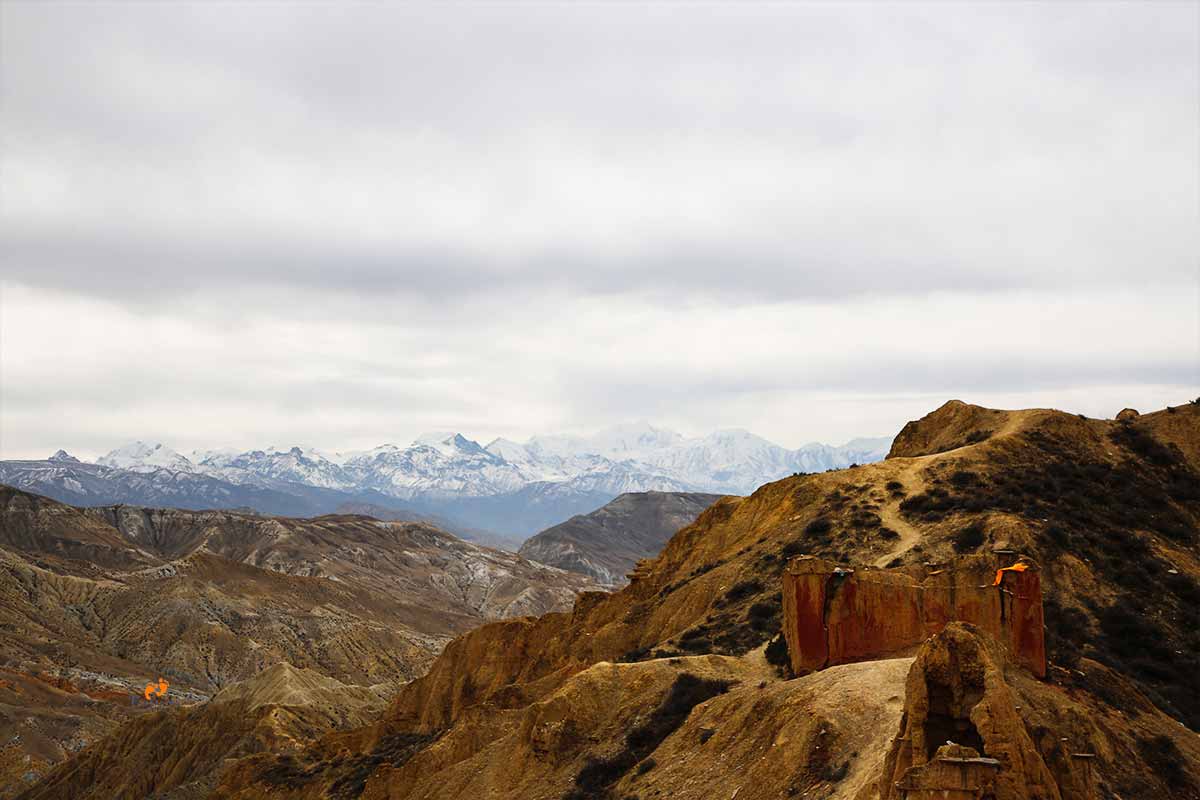
Mustang, often referred to as the “Forbidden Kingdom,” showcases a strong Tibetan influence. The region is divided into Lower and Upper Mustang, each with different permit requirements. Both of these have different permit requirements. In the case of Lower Mustang, trekkers need only an ACAP permit, which allows access to places like Kagbeni and Jomsom by road or air. Upper Mustang is a restricted area, and the permit is USD 500 for 10 days, after that, each additional day costs USD 50 is required for the Upper Mustang trek. This permits and requires restrictions to manage the flow of visitors and help keep the culture and environment of Upper Mustang intact. Lo Manthang includes several walled fortresses, palaces, and monasteries, which are considered a centerpiece for visitors. Other major attractions of the trekkers include Kagbeni, which is considered a gateway to Upper Mustang, and Chhoser Caves with their ancient rock-cut dwellings.
Conclusion
Manang and Mustang are outstanding examples of Nepal's cold deserts, which develop due to the rain shadow created by the Himalayas. High-altitude deserts offer dramatic landscapes carved out in deep canyons with colored rock formations and coniferous vegetation. Resilient human settlers adapted to this extreme environment despite the harsh conditions, and these settlements usually attract thousands of trekkers who come to experience its beauty and cultural richness. The existence of such cold deserts in Nepal shows the diversity of nature, where very towering snow-capped peaks cause dry landscapes, thus giving birth to certain unique geographical features.
Frequently asked questions
Is there any desert in Nepal?
No, Nepal doesn’t have any true desert landscapes, but there is a cold desert in Nepal which is the Manang and Mustang districts.
Which district is known as the desert of Nepal?
The upper regions of Manang and Mustang districts are often called the "desert of Nepal" due to their dry, barren, and rugged terrain resembling a desert-like environment.
Why does the Upper Mustang receive so little rainfall?
Upper Mustang receives very little rainfall because it lies in the rain shadow of the Annapurna and Dhaulagiri mountain ranges. These mountain ranges block the moist monsoon winds from reaching the region, resulting in a dry, arid climate similar to that of a cold desert.
Which region is more desertified, Manang or Mustang?
Mustang is generally seen as more extreme than Manang due to its harsher arid conditions. It receives less rainfall and has a more barren, rugged landscape. While both regions lie in the rain shadow area, Mustang's remote location and rugged terrain create a colder desert environment compared to Manang.



.jpg)



/manang.jpg)



